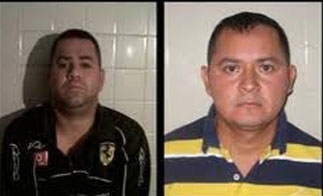While Mexican authorities have dealt a blow to a powerful Guerrero-based gang, the state’s seemingly endless number of emerging gangs suggests that another will soon rise to take its place.
Army personnel arrested Cleotilde Toribio Renteria alias “El Tilde” (pictured, at right), in Mexico City’s wealthy Santa Fe district on July 9, along with an associate named Mario Saul Farfan Ortiz (at left). A spokesman for the Mexican Defense Department (Sedena) later identified Toribio Renteria as the leader of the Guerreros Unidos and Farfan Ortiz as one of his accountants.
Authorities described the Guerreros Unidos as a criminal group operating in the north of Guerrero, a southern state along the Pacific coast, and in neighboring Morelos, which lies further inland. Previous reports of the gang’s actvities support this theory. Last December, for example, a public message, or “narco-manta,” signed by the group appeared in Cuernavaca, the capital of Morelos, taking credit for three dead bodies left nearby. At the time, authorities speculated that the group was behind multiple killings in the Cuernavaca suburb of Texmico and the town of Huitzuco de los Figueroa, Guerrero.
In May, the group authored another manta, which was placed alongside three dead bodies in the city of Cocula, Guerrero. The same day, a message left with a decapitated body in the trunk of a car found in Cuernavaca, which mentioned Toribio Renteria by name, accused the Federal Police of protecting the Guerreros Unidos. Interestingly, each manta accused its enemies of engaging in extortion and kidnapping.
Initially, the Guerreros Unidos were linked to the Familia Michoacana, but in a press conference on Toribio Renteria’s arrest, authorities blamed the group’s fights with the Familia Michoacana and the Beltran Leyva Organization as driving a wave of murders in the region. The Cocula manta mentioned above includes a derogatory reference to the “F.M.”, a likely reference to the Familia.
In terms of public security, Guerrero stands out from other states in a number of ways. According to Mexico’s National Public Security System, or SNSP for its initials in Spanish, Guerrero suffered 2,158 murders in 2011; through the first five months of 2012, the figure was 882. These figures gave the state a murder rate of 64 per 100,000 residents in 2011 and 63 thus far in 2012, comparable to the statistics for violent border states like Nuevo Leon and Tamaulipas.
Guerrero is also far more violent than its immediate neighbors in Oaxaca and Michoacan. The former state, which lies to Guerrero’s east, had a murder rate of 17 in 2011, and is on pace for a figure of just 14 this year. Michoacan, which is as notorious as Guerrero for its criminal groups, remains far safer, with a murder rate of just 18 both this year and last.
One key dynamic distinguishing Guerrero from its neighbors is the vast number of gangs fighting for control of the state over the past several years, which Toribio Renteria’s career amply demonstrates. (InSight Crime reported on this phenomenon last month, though primarily in reference to the Pacific corridor along which Acapulco and Iztapa lie, rather than the northern portion of the state where Guerreros Unidos operates.) Officials said he began his criminal career in 2005 as member of a hit squad working for Edgar Valdez Villarreal, alias “La Barbie”, who in turn worked for Arturo Beltran Leyva around Mexico City and further south in Guerrero.
By August 2010, Valdez Villarreal was in jail and his boss was dead — having been killed in a shootout with marines in Cuernavaca in December 2009 — so Toribio Renteria joined the Cartel Independiente de Acapulco. Not long after, he split with that group to join the Barredora, another Acapulco-based crime group. By 2011, officials say, he had formed his own gang, based in the northern Guerrero cities of Taxco, Iguala, and Ciudad Altamirano, as well as in Cuernavaca.
Guerreros Unidos is not one of Mexico’s more established gangs, neither among the plethora of local groups nor much less compared to the more notorious national organizations. Such smaller gangs often do not survive the downfall of the foremost leader, but given Guerrero’s recent history, another will certainly rise to take its place.

